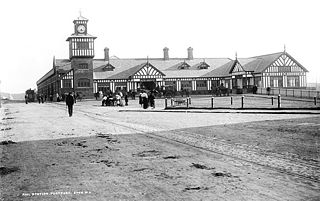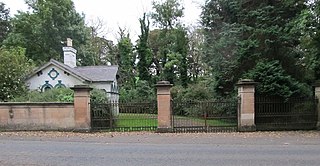Bushmills may refer to:
- Bushmills, County Antrim, a village in Northern Ireland
- Bushmills, a brand of Irish whiskey produced in the Northern Irish village at the Old Bushmills Distillery
Bushmills may refer to:
Bangor or City of Bangor may refer to:

Irish whiskey is whiskey made on the island of Ireland. The word 'whiskey' comes from the Irish uisce beatha, meaning water of life. Irish whiskey was once the most popular spirit in the world, though a long period of decline from the late 19th century onwards greatly damaged the industry, so much so that although Ireland boasted at least 28 distilleries in the 1890s, by 1966 this number had fallen to just two, and by 1972 the remaining distilleries, Bushmills Distillery and Old Midleton Distillery, were owned by just one company, Irish Distillers.
Holy Wood or Holywood may refer to:

Bushmills is a village on the north coast of County Antrim, Northern Ireland. Bushmills had a population of 1,295 in the 2011 Census. It is located 60 miles (97 km) from Belfast, 11 miles (18 km) from Ballycastle and 9 miles (14 km) from Coleraine. The village owes its name to the River Bush and to a large watermill that was built there in the early 17th century. It is home to the Old Bushmills Distillery, which produces Irish whiskey, and is near the Giant's Causeway.

Ballintoy is a small village, townland and civil parish in County Antrim, Northern Ireland. It is alongside the B15 coast road, 28 km (17 mi) north-east of Coleraine, 8 km (5.0 mi) west of Ballycastle and between it and Bushmills. It is in the historic barony of Cary. The village lies about one kilometre from Ballintoy Harbour, a small fishing harbour at the end of a very small, narrow, steep road down Knocksaughey hill which passes by the entrance to Larrybane and Carrick-a-Rede Rope Bridge. The harbour is host to a dawn service on Easter Sunday each year.

The Old Bushmills Distillery is an alcohol distillery in Bushmills, County Antrim, Northern Ireland, owned by Proximo Spirits. Bushmills Distillery uses water drawn from Saint Columb's Rill, which is a tributary of the River Bush. The distillery is a popular tourist attraction, with around 120,000 visitors per year. It produces the Bushmills brand of Irish whiskey.

The Giant's Causeway Tramway, operated by the Giant's Causeway, Portrush and Bush Valley Railway & Tramway Company Ltd, was a pioneering 3 ft narrow gauge electric railway operating between Portrush and the Giant's Causeway on the coast of County Antrim, Northern Ireland. The line, 9+1⁄4 miles (14.9 km) long, was hailed at its opening as "the first long electric tramway in the world". The Giant's Causeway and Bushmills Railway today operates diesel and steam tourist trains over part of the Tramway's former course.

Portballintrae is a small seaside village in County Antrim, Northern Ireland. It is four miles east of Portrush and two miles west of the Giant's Causeway. In the 2001 Census it had a population of 734 people, a decline of 10% compared to 1991. It lies within the Causeway Coast and Glens District Council area.
The Giant's Causeway is an area of 40,000 interlocking basalt columns resulting from a volcanic eruption on the coast of Northern Ireland.

Dundarave is a country house in the village of Bushmills, County Antrim, Northern Ireland. It was the ancestral seat of the Macnaghten family, which is the chiefly family of Clan Macnaghten.

Causeway Coast and Glens is a local government district covering most of the northern part of Northern Ireland. It was created on 1 April 2015 by merging the Borough of Ballymoney, the Borough of Coleraine, the Borough of Limavady and the District of Moyle. The local authority is Causeway Coast and Glens Borough Council.
Saint Columb's Rill is a tributary of the much more famous River Bush in Northern Ireland. This 'rill' or rivulet is really a small stream that rises in bog land approximately five miles southeast of the village of Bushmills in County Antrim. The rill is named after the patron saint of Derry.
The Bank of Ireland £10 note is a sterling banknote. It is the second smallest denomination of banknote issued by the Bank of Ireland.
The Bank of Ireland £20 note is a sterling banknote. It is the third largest of five denominations of banknote issued by the Bank of Ireland.
The Bank of Ireland £50 note is a sterling banknote. It is the second largest denomination of banknote issued by the Bank of Ireland.